Table of Contents
LGBTQ+ Pride has existed long before corporate America chose to acknowledge it and will exist long after. For many, Pride means liberation and finding meaning and community in queer identities. To publicly show pride in one’s LGBTQ+ identity has historically come at a steep cost, with many devoting their lives to queer liberation movements, and far too many losing their lives for the same reason. Choosing to celebrate Pride is to partake in the rich but tumultuous history of supporting LGBTQ+ rights. To stand with the LGBTQ+ community during June – and all year round – is to take a conscious moral stance. Especially during times of political uncertainty for the LGBTQ+ community, businesses that support Pride Month are showing their core values. Let’s deep dive into why your Pride marketing has to be flawless, especially this year.
Take a look at How American Politics Have Affected What’s Popular on TikTok Shop.
The History of Pride
Pride Month isn’t solely rainbow marketing and colorful copywriting. To properly celebrate and commemorate Pride Month, you must know about the history of Pride.
As the saying goes, “The first Pride was a riot.” Pride Month commemorates the 1969 Stonewall Riots against police brutality in New York City. Police raided a small dive bar called The Stonewall Inn, arresting transgender and gender non-conforming individuals for violating the discriminatory “cross-dressing” laws at the time. The patrons of the bar fought back. What resulted was a days-long uprising. Queer people of New York City fought back against police violence and the systemic oppression of the LGBTQ+ community. Scholars debate how many days the uprising lasted, and who threw the first brick.
Be sure to take a look at How TikTok Users are Manipulating the Algorithm for Good.
This was by no means the first riot, and certainly not the first gay civil rights demonstration. Raids such as these had indeed occurred before, and the history of gay civil rights goes back decades. Still, Stonewall was a turning point for what eventually became a rich tradition of Pride celebrations and demonstrations.
@pinknews With Pride officially being just a few days away, here is a look back at what Pride looked like in the 80’s, around the world! #pride #pridemonth #80s #lgbtq #queer #nyc #sanfrancisco
The next year, in 1970, thousands of people gathered to commemorate the first anniversary of the Stonewall Riots. They gathered in New York, Los Angeles, and Chicago to commemorate the riots and demonstrate for equal rights. These demonstrations were adapted from “Reminder Day Pickets” of the late 1960s, where queer activists held annual demonstrations on July 4th at Independence Hall in Philadelphia, Pennsylvania. Now, these demonstrations not only commemorated Stonewall but a long history of queer activism.
Take a look inside the “Dinosaur Time” TikTok trend here.
That first demonstration after Stonewall was named Christopher Street Liberation Day, and activists and participants saw resounding success. The Christopher Street Liberation Day Committee then dubbed the week of June 22nd – 28th as Gay Pride Week.
In May 1971, activist Foster Gunnison Jr reflected on the successful demonstration: “…And each of these 5,000 homosexuals had a new feeling of pride and self-confidence, for that was one of the main purposes of the event–to commemorate, to demonstrate, but also to raise the consciences of participating homosexuals–to develop courage, and feelings of dignity and self-worth.”
And from these and many demonstrations and traditions, Pride Month was born!
Pride Today
Pride today consists of many major tenets of the Pride marches before. Queer people show up to major cities to wave not only the rainbow LGBTQ+ flag, but other specialized flags for lesbians, gay men, transgender individuals, bisexuals, and many more identities. The biggest marches take place in New York, Chicago, Washington D.C., and San Francisco. However, over the years, many more cities have added their own celebrations all across the United States.
@phillypublicist Philly made history 🥹 America’s biggest rainbow pride flag debuted at the famous Rocky steps at Philadelphia Museum of Art. See it Sunday June 2nd at the Pride March – and have a happy pride! #philly #philadelphia #pride #pridemonth #prideflag #rainbowflag #lgtbq #pridemarch #prideparade
♬ This Is Me (From “The Greatest Showman”) – Riverfront Studio Singers
Pride allows queer people to not only celebrate themselves and their queer identities but to continue pushing for queer liberation and civil rights.
LGBTQ+ people in the United States are continuously attacked legislatively, with the government pushing legislation that infringes on their rights. President Donald Trump entered office with a barrage of Executive Orders, targeting not only the rights of the LGBTQ+ community but many other marginalized individuals. Among those included an Executive Order to deny trans people passports and restrict access to healthcare. The administration also released an Executive Order attempting to bar the Smithsonian Museum from mentioning trans people and LGBTQ+ history.
These, and more anti-LGBTQ+ measures are emboldening lawmakers to call for the overturn of Obergefell v Hodges, a landmark Supreme Court case that legalized gay marriage nationwide in 2015. These calls to overturn Obergefell v Hodges strike fear into many members of the LGBTQ+ community, especially seeing as another landmark case, Roe v Wade, was overturned in 2022, causing huge restrictions on reproductive rights and other medical care for women and queer people.
Across the board, the Trump administration rolled back Diversity, Equity, and Inclusion initiatives. This then prompted other corporations to do the same, further hurting the hiring of women, queer people, and other marginalized groups in the workplace.
Despite the tumultuous political landscape, queer people know what it’s like to not only fight for their civil rights but also celebrate their communities and identities, even and especially in times of crisis. Pride 2025 will go on as planned – if not become a bigger and brighter event in light of political turmoil.
Why Your Pride Marketing has to be Flawless in 2025
Knowing all of this, where does Pride marketing come into play? By partaking in Pride, your business recognizes a vast history of civil rights work on the part of the LGBTQ+ community. Taking a public stance as a supporter of the queer community, and refusing to publicly back down when the community is attacked on all sides is a strong and conscious moral stance.
Supporting and showing Pride may look different for every business engaging in Pride marketing. For a brick-and-mortar business, flying the Progress Pride flag is a great way to show your support. As a business, you may want to make a public donation to a group pushing for LGBTQ+ rights. Publicly doing so may encourage your patrons and customers to do the same, furthering your positive Pride marketing.
Progress Pride Flag, Now Gallery, The Victoria and Albert Museum
Don’t miss How BookTokers are Editing the Publishing Industry.
For many, spotlighting queer voices is the perfect way to raise awareness about issues. Consider building relationships with local groups and activists. For those in influencer marketing, inviting queer influencers to speak at in-person events or on podcasts can celebrate the LGBTQ+ community during Pride Month and all year round.
@gaytimes Drag icon @BIMINI spoke to @We Need To Talk about brands who only support Pride when it’s profitable 👏 #dragrace #rupaulsdragrace #dragraceuk #bimini #dragracecontent #nonbinarytiktok #drag #ComfortSegredos
Businesses must be incredibly cognizant of how they present their Pride marketing. Pride marketing can and should be a reflection of the company’s values, especially values of diversity and inclusivity. Yet, too many businesses – usually large corporations, but not always – fall into the trap of rainbow capitalism. That is, using Pride to spin a profit.
Rainbow capitalism is when a business only shows up in performative ways, such as selling Pride merchandise during June only to never say a supportive word towards the LGBTQ+ community for the rest of the year. In this way, the Pride merch, or Pride marketing is only to capitalize off the years of queer civil rights history that has brought us modern Pride Month. Rainbow capitalism is not in solidarity with the LGBTQ+ community, and brands who engage in these empty sentiments, like posting a rainbow flag once a year or profiting off Pride merchandise, are not aware or authentic with their marketing campaigns.
Overall, June is a historic month for the LGBTQ+ community. Embrace the decades of civil rights resistance and queer history and celebrate Pride in June and all year round.
























